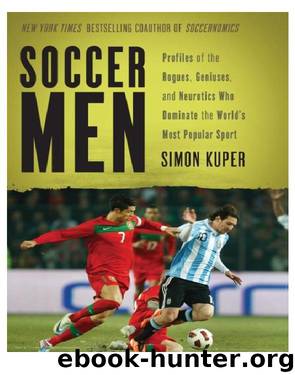Soccer Men by Simon Kuper

Author:Simon Kuper
Language: eng
Format: epub
Publisher: Nation Books
Published: 2011-08-18T16:00:00+00:00
Lionel Messi
May 2010
Opinions differ as to who first put Leo Messi on a soccer field. His dad says the boy’s grandma forced the coach, Don Salvador Ricardo Aparicio, to let the tiny five-year-old play with his older brothers. Aparicio’s own version was that he only had ten players and, spotting the tyke kicking a ball against a wall, asked Messi’s mother, “Will you lend him to me?”
Opinions converge on what happened next. Messi’s mom dressed him in the team’s uniform. The first ball came to his right foot, but nothing happened. Then a ball fell to his left. “He came out dribbling as if he’d played all his life,” “Apa” later recalled.
A stray foreigner witnessing the moment in the fading Argentine river town Rosario, birthplace of Che Guevara, a place that time forgot, might have gasped. Argentines didn’t. They recognized Messi at once: He was the pibe, “the boy,” they had been waiting for.
Usually the main suspense before a World Cup concerns who will win it. This year, people are just as eager to know whether in South Africa we will see the full Messi. If he can match some of the moments he has given us with Barcelona, but in soccer’s ultimate setting—well, the game doesn’t get better than that. This World Cup is in large part about Messi. But to understand him, you have to understand his Argentine football ancestry.
It was sociologist Eduardo Archetti who explained the pibe to me, one day in Buenos Aires in 2000. The pibe, Archetti said, is a figure that Argentine soccer fans have had in their minds at least since the 1920s. The pibe learns his soccer on the potrero, a bumpy urban space, where only those who can dribble can keep the ball. He plays the creative game that Argentines call la nuestra, “ours,” a style that they say comes from a child’s imagination. In 1928 journalist Borocotó proposed in the great Buenos Aires soccer magazine El Grafico that Argentina build a monument in “any walkway” to the inventor of dribbling. The statue, Borocotó wrote, would depict “a pibe with a dirty face, a mane of hair rebelling against the comb; with intelligent, roving, trickster and persuasive eyes and a sparkling gaze that seem to hint at a picaresque laugh that does not quite manage to form on his mouth, full of small teeth that might be worn down through eating ‘yesterday’s bread.’”
You may recognize the description. Indeed, when Maradona came along fifty years later, Argentine soccer fans had been expecting him. A tango, “El sueño del pibe” (Dream of the pibe), had been written about him in 1943. In the song, which Maradona has sung in public, a young pibe likens himself to bygone legends:Dearest Mamita,
I will earn money,
I will be a Baldonedo,
A Martino, a Boyé
Download
This site does not store any files on its server. We only index and link to content provided by other sites. Please contact the content providers to delete copyright contents if any and email us, we'll remove relevant links or contents immediately.
| Baseball | Basketball |
| Boxing, Wrestling & MMA | Football |
| Golf | Hockey |
| Soccer |
Imperfect by Sanjay Manjrekar(5806)
Wiseguy by Nicholas Pileggi(5674)
The Body: A Guide for Occupants by Bill Bryson(4976)
Tuesdays with Morrie by Mitch Albom(4695)
Unstoppable by Maria Sharapova(3484)
Not a Diet Book by James Smith(3341)
Crazy Is My Superpower by A.J. Mendez Brooks(3332)
Into Thin Air by Jon Krakauer(3314)
The Mamba Mentality by Kobe Bryant(3190)
The Fight by Norman Mailer(2849)
Finding Gobi by Dion Leonard(2783)
Tuesdays With Morrie by Mitch Albom(2697)
The Ogre by Doug Scott(2634)
My Turn by Johan Cruyff(2577)
Unstoppable: My Life So Far by Maria Sharapova(2453)
Accepted by Pat Patterson(2307)
Everest the Cruel Way by Joe Tasker(2280)
Borders by unknow(2232)
The Quarterback Whisperer by Bruce Arians(2219)
